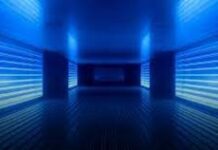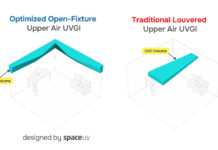The Aim: Evaluate UV-C GUV for Indoor Air Quality, Health Outcomes, Energy Efficiency
By Liz Stevens
Light Progress, Minneapolis, Minnesota, a maker of UV-C disinfection technology, in partnership with Minnesota electrical contractor Noble Electric, has completed the pilot installation phase of a germicidal UV-C study project at Cardigan Ridge, a Minneapolis memory care and senior living community. Light Progress Group CEO Guilia Santi described the endeavor. “The hypothesis is that by strategically integrating UV-C technology,” said Santi, “we can achieve improved indoor air quality, lower energy costs and facilitate better health outcomes – particularly for vulnerable populations – as compared to a strategy of increasing outdoor air intake or upping the HVAC filter grade to achieve similar goals.” The project’s partners include Light Progress, Cardigan Ridge, NALMCO (International Association of Lighting Management Companies), Network Thermostat, Noble Electric and Purdue University.
The installation of UV-C air disinfection technologies was completed in September 2024. Data collection of CO₂ levels, thermostat readings and IAQ (indoor air quality) parameters now is ongoing. Air quality-related health outcome tracking includes monitoring infections and disease spread among residents and staff. The study will span one year, concluding in September 2025.
“The existing HVAC system at Cardigan Ridge is unchanged,” said Santi. “This study focuses on enhancing indoor air quality through UV-C integration, while ensuring compliance with ASHRAE 241, Control of Infectious Aerosols, in a cost-effective manner without requiring major system modifications.” The project employs upper room germicidal UV-C (URGUV) systems, HVAC-integrated germicidal UV-C technology and in-room air purification devices. The goal is to evaluate UV-C technology’s impact on air quality, health and energy efficiency in a residential care environment. The installation incorporates UV-C devices certified for germicidal efficacy and safety, aimed at achieving improved air changes per hour while optimizing energy use, thus demonstrating that high indoor air quality can be maintained without increased energy demands on existing HVAC systems.
Noble Electric performed the installation, with expertise certified through the NALMCO GUV Certification Program for professional lighting management. The equipment in use includes HVAC-integrated germicidal UV technology in the main ductwork of the Cardigan Ridge HVAC system. These duct-mounted drill-and-fill devices are designed for on-the-fly airflow disinfection. URGUV systems were installed in common areas and employee areas, in wall-mounted and ceiling-mounted form factors. In-room air purification devices were installed in dining areas where ceiling or wall-mounted URGUV was impractical. And portable UV-C air disinfection units that also reduce VOCs were added.
“Following the URGUV installation,” Santi said, “we collaborated with Noble Electric to conduct a safety verification, adhering to NALMCO training guidelines. All team members were NALMCO-certified and followed strict safety protocols.” The photobiological safety testing (aligned with UL standards) confirmed that every installation height and angle ensured compliance with the ACGIH Threshold Limit Value (TLV) of 0.2 µW/cm². A radiometer was used to map entire rooms, identifying potential hotspots. All measurements fell well below the safety threshold, ensuring zero risk to occupants. Stakeholders were reassured through comprehensive post-installation education. “Residents and staff welcomed the technology,” Santi said, “demonstrating that with proper education and communication, UV-C is seen as a risk prevention tool rather than a hazard.”
The project also uses thermostats from Network Thermostat, Grapevine, Texas, a maker of HVAC control solutions with a focus on energy efficiency and data monitoring. These thermostats integrate HVAC control, ventilation control and UV-C control, and have real-time monitoring sensors and data-logging to track CO₂ levels as a marker of indoor air quality and ventilation efficiency. This data will provide insights into how UV-C technology enhances air changes per hour. “While CO₂ monitoring is a key component,” Santi said, “we also are tracking a full range of IAQ metrics to comprehensively assess UV-C’s impact.”
“The study encompasses the entire Cardigan Ridge facility and focuses on common areas that are ideal for URGUV implementation,” said Santi. “Additionally, we retrofitted the existing HVAC system with UV-C devices installed in the main ductwork. In dining areas, where ceiling and wall installations were impractical, we deployed portable in-room air purifiers operating during peak occupancy hours (breakfast, lunch and dinner). While our primary focus is on resident common areas, we also installed UV-C systems in employee areas to mitigate external sources of infection and protect the workforce as well.” The study compares facilities with and without UV-C integration, evaluating air changes per hour, energy consumption and indoor air quality metrics.
A project partner – the Lyles School of Civil and Construction Engineering at Purdue University, West Lafayette, Indiana – will perform comprehensive analyses of the role of GUV technology in maintaining air quality. The Lyles School specializes in sustainable infrastructure and cutting-edge research. To provide actionable insights and validate the practical benefits of UV-C applications, Purdue researchers will conduct modeling and simulations of the UV-C systems. They will map UV-C intensity and distribution to ensure compliance with safety standards while optimizing GUV efficacy. They also designed and simulated ASHRAE 241-compliant strategies to gauge the effects of UV-C technology on air changes per hour.
Health data from Cardigan Ridge residents and staff will be compared to historical records and to data from nearby control facilities, allowing researchers to identify and quantify UV-C systems’ specific benefits in enhancing health outcomes. “We established a control group by monitoring four similar assisted living facilities under the same ownership within the same geographical area,” said Santi. “These facilities have identical layouts and HVAC systems, allowing for direct comparisons between sites with and without UV-C technology.” The health outcomes being measured include flu cases, respiratory infections, and other illnesses among residents and staff.
“The formal study period will conclude in September 2025,” Santi said, “with analysis and reporting following shortly thereafter. The project’s findings will inform future applications of UV-C technology, supporting its adoption as a reliable solution for indoor air quality challenges.” UV Solutions will report on the results of the study after it has been completed.
IUVA Connections
This study came into being with the help of information shared by and relationships facilitated by IUVA. In July 2023, Light Progress installed a small-scale application of URGUV in an Austin, Texas church, using the ASHRAE GPC-37 commissioning process featured in “GPC 37: Guidelines for the Application of Upper-Room Germicidal Ultraviolet (UV-C) Devices to Control Transmission of Airborne Pathogens: A Preview,” in the 2022 Q4 issue of UV Solutions (https://bluetoad.com/publication/?i=771334&p=32&view=issueViewer). Light Progress submitted that project for inclusion in the Pacific Northwest National Laboratory study on URGUV, led by the Department of Energy and Gabe Arnold. Light Progress then presented its commissioning results, “Applying the Commissioning Process Embedded in the ASHRAE GPC 37 Guideline,” at the 2023 IUVA World Congress, Dubai.
At the Dubai conference, NALMCO’s Erik Ennen connected with Light Progress, described NALMCO’s GUV training and certification, and then connected Light Progress with Noble Electric, a NALMCO-certified Minneapolis company doing work in Minnesota assisted living facilities. Light Progress saw an opportunity to collaborate with Noble Electric to implement ASHRAE 241 guidelines for validation in a real-world environment. Light Progress also partnered with Network Thermostat to incorporate that company’s robust thermostat ecosystem’s HVAC control, ventilation control, UV-C control, CO₂ monitoring and on-device data logging technologies.
Light Progress attended the 2024 IUVA Americas Conference in Orlando, Florida, where Dr. Chip Blatchley of Purdue University presented “Decision Making in the Context of ASHRAE 241,” on his research in evaluating facility compliance with ASHRAE 241 through the Infection Risk Management Model and via quantifying equivalent clean airflow rate (𝑉_𝐸𝐶𝐴𝑖). Light Progress invited Purdue University to collaborate in the Cardigan Ridge project, benefiting from Purdue’s expertise in fluence rate calculation and performance assessment of GUV systems, as well as the institution’s 3D CFD modeling to evaluate irradiance levels and equivalent air changes per hour, its simulation of real-world outcomes, and its expertise in the seamless integration of UV-C into existing HVAC systems.
For more information, visit www.lightprogress.com.






